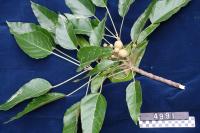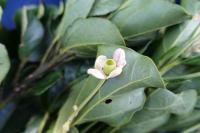Your search for * in medicine / cuts has returned 13 entries
incei u nasuantan

n. herb to 1 m, flowers blue. In transitional zone from pine forest to ’primary’ forest. (collection: Michael J. Balick #4982)
Example: This is used to treat Ciguatera disease when a person eats fish that is contaminated. Squeeze juice from a handful of leaves of this herb into a cup, add a small amount of water, and drink 1 cup once a day for 3 days, or continue until the person feels better. This illness is a problem on Aneityum with the reef fish. It is better to eat fish that are farther out to sea. This treatment is also used for dogs who eat contaminated fish. Make the same preparation and forcibly pour this in their mouth as they will not drink it willingly. Do this treatment once daily until the dog feels better. The dogs get this illness because they are fed the scraps, especially the bones of the fish, and this is thought to be where the disease is found. This is considered to be a dangerous illness and dogs who get it frequently die.
bookmarkincei u nasuantan

n. subshrub, 0. 5 to 0. 7 m tall (collection: Gregory M. Plunkett #3212)
Example: The common name of this plant means "the plant that belongs to Nasuantan" that being the person who introduced it to Aneityum. He was a person taken from the island as a blackbirder and came back with this plant. It is used for medicine. When a person gets a fresh cut, squeeze the juice from the leaf and put the liquid on the cut to help it heal.
bookmarkinmac

n. tree to 10 m, dbh 1 m (collection: Michael J. Balick #4991)
Example: The young trees are a good source of lumber as they are straight and can be used as poles or sawn timber. This tree is also a source of firewood and is known to be easy to light and burns well. The fruits are a source of oil. Collect the ripe fruits, remove the seeds from the shell, macerate the seeds to release the white endosperm inside, place this in a pot without water and heat it. The brown-yellow oil will come out from the crushed fruits. It is good for using on the body but not edible. It is a good massage oil, or to lubricate the skin or to heal small wounds. For the latter, drop some oil on the wound once daily until the wound heals.
bookmarkinmadidi

n. tree to 5 m, dbh 8 cm (collection: Michael J. Balick #4855)
Example: To treat a flu that has resulted in a thick, runny nose, collect sap of this tree, drink 2-3 drops directly (not in water). This is for treating the type of flu that provokes yellow mucus coming out of the nose. Drinking the sap breaks up the stuffy nose. Use once, it tastes very sour. In 3-4 days the mucus will be expelled. Do not use too much! If a person has a new cut, and the bleeding will not stop, place the sap on the cut and the bleeding will stop. If you have a burn that is bleeding, applying the sap will stop the blood and oozing sore. If a person has a sore on their body, cover it with a layer of the sap from this plant. This will ensure that the sore will not get larger from infection, flies, etc. but stay its original size. This plant is also used for unspecified spiritual practices. To determine if a fish you have caught is poisonous, e.g. with ciguatera, take an 8’ piece of small branch from this tree, peel the bark and put it inside the fish before you cook it on the earth oven. If the stick turns black, then you know that the fish is not good to eat--it has a poison so should be thrown away.
bookmarkinmowad

n. vine to 40 cm, flowers blue (collection: Michael J. Balick #4949)
Example: To heal cuts, select a piece of the larger part of the stem (woody) cut a 6 inch piece and blow on one end; the sap comes o ut on the other end and this can be used to cover the wound. As a pig feed, people collect the stems and leaves and feed these to the pigs.
bookmarkinpece

n. tree to 15 m, dbh 50 cm (collection: Michael J. Balick #4918)
Example: The fruits of this tree are collected, mixed with ground coconut, boiled in water and the oil collected. The resulting oil is used medicinally, put on the skin for any condition to promote healing. Apply once a day until the condition resolves. Also can be used to treat head lice. Add the oil mixture to the hair, massage in, keep the hair dry for a day, then wash. Use once daily for 3 days.
bookmarknaipom̃yiv

n. terrestrial plant, 60 cm tall (collection: Gregory M. Plunkett #3498)
Example: Children take a shoot of this plant and make a whistle from it. However, when children do this, they are told not to, as it will attract the rains, or a snake, that will hear the noise and come to the person. This is a folk belief. The base of the shoot of this plant is chewed and applied to fresh cuts as a styptic. Pull out top growth of plant that has not flowered and blow on it like a whistle. Ancestors used this as a whistle to attract snakes for edible – not today. Name means “balls or heaps of snakes” refer to their attraction.
bookmarknaipomyiv ~ naipomñiv

naparap

n. epiphytic fern on main tree trunk, growing in dry forest. (collection: Gregory M. Plunkett #3504)
Example: This is a medicine to treat fresh cuts. Take the leaf of this species, macerate it and add 1 tablespoon of water and wrap in a Macaranga leaf, and then heat it on a fire. After heating, puncture the side of the Macaranga leaf and drop the hot juice on the fresh cut. This is said to be good before going to see the Dispensary or if you do not have access to a health care professional.
bookmarknasjiramnem

n. grass to 20-30 cm tall, florets brown. Growing along trail. (collection: Michael J. Balick #4970)
Example: This plant is used to make a medicine to stop bleeding, as a styptic. Squeeze a handful of leaves together and apply the leaves as a poultice to the wound or drip the juice on the wound when it does not seem wise to put pressure on the bleeding. This will stop the blood from flowing from the wound and is only to be used on a small wound.
bookmarknehep

n. tree, 15 m tall (collection: Gregory M. Plunkett #3590)
Example: 1. Used as a medicine to help stop bleeding. Take the inner bark, mash it, and dip in water. Then apply the poultice to the bleeding wound to help stop the bleeding. This treatment will also promote healing of the wound. When the poultice dries it becomes hard and sticks to the wound. At that point leave it on the wound until the pain goes away and then it can be peeled off of the wound. 2. Wood good for making canoe.
bookmarknehep

n. large tree, 15-20 m tall (collection: Gregory M. Plunkett #4062)
Example: 1. The trunk of this tree is used to make the body and outrigger of a traditional canoe. 2. The inner bark is used as a bandage for cuts and wounds. When the inner bark is grated it yields a sticky substance. The sap acts as a liquid stitch and reduced the chance of scarring. When this is dry one must use a knife to remove the residue.
bookmarkneheptal

n. tree to 15 m tall, dbh 25 cm (collection: Michael J. Balick #4903)
Example: Wood is used to make canoe as it is very light and lasts in salt water. As a styptic to stop bleeding, when a person gets a cut in the bush, scrape off outer bark and use inner bark scrapings to put on cut. Stops bleeding, leave on for one day.
bookmark


